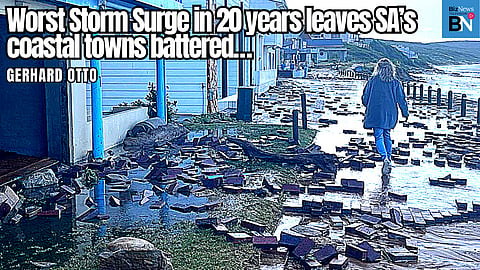Worst Storm Surge in 20 years leaves SA’s coastal towns battered…
The storm surge that battered South Africa's coastal towns – leaving death and destruction in its wake – was the worst in 20 years. That is according to Gerhard Otto, the Head of the Disaster Management Centre of the Garden Route. He speaks to BizNews after a stormy weekend in which freak waves crossed roads in tsunami-like fashion to flood restaurants, homes and parking lots. He reveals the extent of the damage to infrastructure – and says that longer term repair work could take between six months and a year. He lists the factors that combine to form "perfect storms; explain why they could get even bigger in future – and appeals to the public to heed storm surge warnings. – Chris Steyn
Sign up for your early morning brew of the BizNews Insider to keep you up to speed with the content that matters. The newsletter will land in your inbox at 5:30am weekdays. Register here.
Watch here
Relevant timestamps from the interview
- 00:46 – Introductions
- 01:01 – Gerhard Otto on the damage caused the past weekend
- 02:39 – What factors combined to create the perfect storm
- 03:31 – Municipalities that were worst hit
- 05:13 – Businesses must heed warnings
- 07:35 – Is climate change worsening?
- 08:01 – Is it over or should people be careful
- 08:46 – Any casualties linked to the storms
- 09:50 – How long the mop up operations will take
- 10:44 – Conclusions
Listen here
Highlights from the interview
The storm surge that battered South Africa's coastal towns – leaving death and destruction in its wake – was the worst in 20 years.
That is according to Gerhard Otto, the Head of the Disaster Management Centre of the Garden Route.
He speaks to BizNews after a stormy weekend in which freak waves crossed roads in tsunami-like fashion to flood restaurants, homes and parking lots.
"I must say it's been the highest that the water has come in the last 20 years. The last event of this nature was in September 2008 – and it didn't come as high as this time."
Asked what factors combine to cause such a perfect storm, Otto says: "It's when you've got this exceptional high tide and you've got a storm on the sea with the wind driving those tides much higher than it normally comes. And that's when you get these types of damages."
He says the Weather Office had provided a Yellow Level Warning. However it went unheeded by many people.
"I spoke to my colleagues at the Weather Office to say maybe it should have been an Orange Level 5 or 6 because really the impact was much worse than we expected it to be…and what we find is people sometimes don't…realise how dangerous it is to go and – as a spectator value – visit these areas and that's why we also lost the lady, an elderly lady, over the weekend that was washed from the rocks."
Otto appeals to the public to listen to the Emergency Services when they restrict access to certain areas. "People don't realise that the waves come where they normally don't come. So where you think it's safe to be on the rocks, the next moment it's not safe and you can be washed off of those areas….And it causes a lot of problems for the emergency workers….They do what they do because of a reason and we know where it is safe for you to go and not to go."
He warns that with climate change "normal is not the normal anymore". "So every time this line gets moved higher and higher up. You must remember the areas above the high water mark, we call them softer areas, because the water never reaches those areas. Now suddenly with a storm surge, the water will reach those areas…and those areas are not protected…"
But for now, Otto says, the storm surge as predicted by the Weather Office is past. "I can't say it's past forever, but when I looked at my history and the data in it, the last one was also in September 2008. So it seems like September is the month we must watch out for these types of freak storms coming through. I won't say it's past for the season;we can get similar events in this month … .so, we will advise people again – and hopefully this time they will listen to our warnings."
Extensive mop-up operations are being carried out. "They're busy with repairs to critical infrastructure, transformers, et cetera. Our roads teams yesterday were working on some of the roads in the coastal areas that needed to be graded so that we can again get access to those areas."
However, the longer term operations where municipal infrastructure and utilities washed away could take a while. "Some of them might not be repaired, might not be rebuilt because… they are just not placed in the right area anymore. So with the previous storm surge, we decided some of the bathrooms, et cetera, that got washed away, we had to just move them. That's all we could do, move them to higher ground. So this can take the next six months to maybe even a year in some areas."
Meanwhile, the financial losses suffered as a result of the storm damage are still being assessed on the ground.
Read also:
- Andrew Kenny on Mangosuthu Buthelezi: A complex legacy in the struggle against apartheid
- Eskom ex-CEO André de Ruyter under legal fire for private probe and security contract
- SA Presidency's R88.5 billion anti-poverty plan despite Treasury's budget warning
- Premium from the FT – How world sees SA: A fire in Joburg symbolises entire system up in flames
*Photos and videos supplied by The Disaster Management Centre – Garden Route

